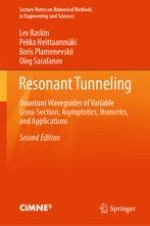This book studies electron resonant tunneling in two- and three-dimensional quantum waveguides of variable cross-sections in the time-independent approach. Mathematical models are suggested for the resonant tunneling and develop asymptotic and numerical approaches for investigating the models. Also, schemes are presented for several electronics devices based on the phenomenon of resonant tunneling. Compared to its first edition, this book includes four new chapters, redistributes the content between chapters and modifies the estimates of the remainders in the asymptotics of resonant tunneling characteristics. The book is addressed to mathematicians, physicists, and engineers interested in waveguide theory and its applications in electronics.
